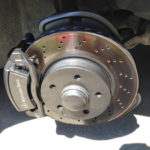Can you believe that the first brake systems were wooden blocks controlled by a lever? They used to be put on steel-rimmed wheels that steam-powered vehicles featured back in late 1800s. Of course, with the introduction of rubber tyres and mechanical brakes everything about it changed, as later on, hydraulic, disc and self-adjusting brakes were introduced as well as safety features like ABS and AEB. Since brake discs came out a bit later, brake pads are considered a newer type of brake technology than brake shoes.

Types of Brake Pads
Organic
In the past, asbestos was the base material of brake pads since it is great at absorbing heat, but later on it was replaced by a combination of rubber, glass, resin and a small percentage of metal fibres. This is what we call organic brake pads and rotors today. These pads are the softest on the market, but they do not put a lot of stress on the brake rotors and do a fairly good job for everyday commuters. But since they are the cheapest option, organic pads wear out quickly and they don’t work as well in extreme weather conditions.
Metallic (Semi-Metallic)
These brake pads are found in the majority of vehicles today as they are quite effective. They produce a lot of brake dust too and tend to be noisy. Metallic pads are made from 30% to 70% metal including iron, sintered steel, graphite, copper, other composite alloys and synthetics. They also have a high thermal conductivity and are more resistant to wear.
Ceramic
The most expensive and most silent pads are definitely the ceramic ones. They are also the best when it comes to operating in a wide range of driving conditions and temperatures. They also tend to produce less dust as they do not wear down as easily as metallic or organic pads. Ceramic pads are made of the same type of ceramic that is used to make plates and pottery, it’s just more durable and denser. They also have fine copper fibres that help with friction and heat conductivity.

How to Check Brake Pads
Without Removing the Wheel
This is the easiest and fastest way to check the state of your brake pads, unless the holes in the wheels and rims are too small. Take a flashlight that can fit between the holes in the rims and check out the material left on the pads – if it’s less than 6mm thick, then you might need to replace them. Some pads may have a wear indicator slot on the centre and if that slot is barely visible or completely gone, you know what needs to be done.
By Removing the Wheel
To inspect the pads without the wheel attached, you’ll need to position the vehicle about 1.8m above ground level. You should unscrew the lug nuts, remove the tyre and look for the same minimum level of thickness. Again, if there isn’t enough pad material, you’ll need to do a replacement, be it at a mechanic or on your own.
How Often Should You Change Your Brake Pads and Rotors?
A good rule of thumb is to change your pads about every 16,000km – 32,000km and for rotors it’s usually every 80,000km – 112,000km.

Extend Lifespan
Surely, visiting the mechanic from time to time will help keep your braking system in good shape, but there are some things that you can do everyday to help extend the life of the pad and rotor. You can plan ahead whilst driving, meaning when you are approaching a stop sign, a turn or traffic jam, you can simply slow down whilst approaching the stopping point instead of hitting your brakes right before it. When on the motorway, just lift your foot off the pedal as soon as you see brake lights.
With this next tip you can even save on petrol and it has to do with coasting. Basically, when you see a red light, don’t hurry in order to stop as this way you are wasting petrol to get in line and then slam the brakes once you get there. Instead, start coasting and slowing down. You should include coasting more in your everyday driving, which means you should pay more attention to the flow of the traffic and cars that are slowing-down or stopping in front of you.
Try to slow down before hitting the brakes, for example when you are driving 100km/h try to slow down to 80km/h if you can and then apply the brake – this will help the brakes dissipate 33% more energy which means less heating and a longer lifespan.
When driving on a motorway junction, coast between 80km/h and 120km/h then press the brakes to slow down the rest of the way. I know this next one is kind of a rookie’s mistake but you should avoid pressing both the accelerator and brake pedal at the same time as it creates more brake taps which cause premature wear. When going downhill drive in the lowest gear that allows you to drive at a safe speed and if your vehicle speeds up engage the brakes periodically for about five seconds with light pressure.


